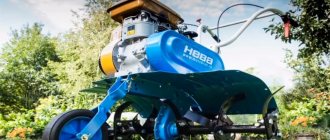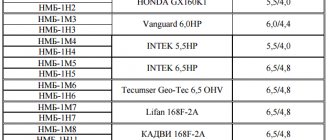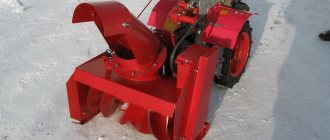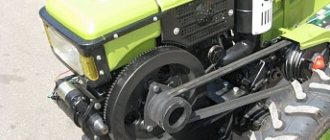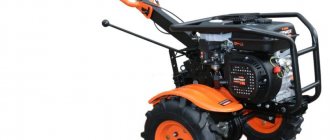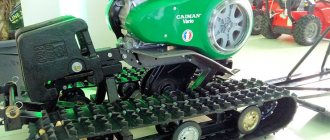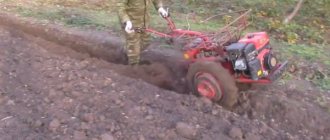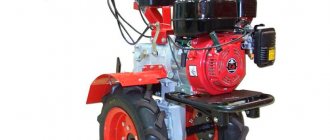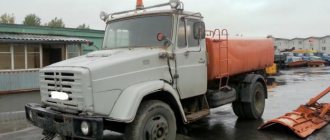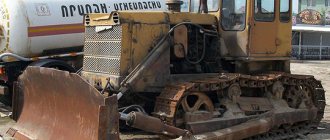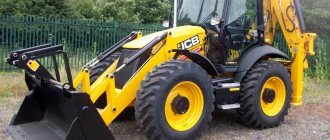Motoblock “Ugra NMB-1N7”
The Ugra NMB 1n7 walk-behind tractor is the brainchild of the Kaluga motor plant KaDvi, which produces heavy equipment and spare parts for small, medium and large farms. Initially, the plant was engaged in the production of engines and spare parts for tractors, but in the late 80s an experimental workshop was opened for the production of Ugra and then Oka walk-behind tractors.
Motoblock Ugra NMB-1N7
A walk-behind tractor is a multifunctional technique that allows its owner to completely mechanize all processes in cultivating soils (of any density), as well as perform mechanical planting of plants and subsequent harvesting. Equipment manufacturers took into account all the needs of small and medium-sized landowners, expanding the capabilities of their machines - various functional mounted and trailed equipment appeared:
- plows;
- soil cutters (cultivators);
- lug wheels;
- harrows;
- hillers;
- pumps;
- wood splitters;
- feed crushers;
- potato planters;
- potato diggers;
- borax;
- mowers;
- snow removal equipment (brushes, blades, rotary snow blowers);
- adapters;
- trailer trolleys, etc.
It is important to note that the Ugra NMB 1N7 walk-behind tractor can easily be used to mount mounted and trailed implements from other manufacturers.
Motoblock NMB-1 Kadvi. Description and operating experience. Design of the NMB-1 walk-behind tractor.
It's time for me to update my walk-behind tractor. Before that, I had an old MB-1 manufactured in the early 90s, which honestly worked out its life, cultivating the garden and transporting all sorts of cargo using a trailer.
And he even turned a concrete mixer! Despite the many shortcomings of its design, in general I did not have and do not have any special complaints about it (it still remains in service). And although something constantly had to be faked or repaired, these repairs were always carried out within a few hours and it was possible to make do with improvised materials. Those. I was quite satisfied with the reliability of the Kaluga walk-behind tractor MB-1, especially considering its price.
Therefore, I decided not to look for good from good and added a small detour to one of my trips with the aim of visiting Kaluga (as it is now called) and purchased a relatively new model of the NMB-1 walk-behind tractor there. (By the way, the old model MB-1 is still in production there, and has undergone quite a serious modernization).
This fall, I managed to work a little on the HMB-1 walk-behind tractor and I want to share my impressions with readers who may be planning to buy a walk-behind tractor and are experiencing the agony of choosing “how and which walk-behind tractor to choose.” I will describe it in comparison with the old model of the MB-1 walk-behind tractor. Moreover, it is still produced by Kadvi.
The photo shows a general view of the HMB-1 walk-behind tractor. As you can see, it differs quite a lot from the MB-1. Although the engine itself remained practically the same, and even the gas tank was the same, the power system (carburetor, air filter) and muffler were radically updated. Subjectively, the new walk-behind tractor is much quieter.
The fundamental difference between the HMB-1 and the MB-1 is the appearance of a 4-speed gearbox. 3 speeds forward, 1 reverse. This required turning the engine 90 degrees relative to the wheel axis.
Also, instead of a chain gearbox, a gear with a transmission shaft is installed on the walk-behind tractor.
Well, let's take things in order.
Protective wings also appeared over wheels or cultivators. Obviously, their purpose is to protect the worker’s legs from injuries during cultivation and from dirt when transporting the cart. Although I don’t quite understand how, holding the handles of the walk-behind tractor, you can reach these same cultivators with your feet. But they actually interfere with work. Although I’m probably just used to controlling the cultivation process when cultivating the soil. The good thing is that the wings are fairly easy to remove. They are fastened with 4 nuts each and removed - installed in 5 minutes.
In front of the walk-behind tractor there is a folding frame - a support on a spring. It provides quite comfortable parking. Moreover, it is removed almost “automatically”. It is enough to start moving forward, tilt the walk-behind tractor slightly and the frame itself snaps into the “stowed” state. I, not accustomed to such a service on the MB-1, at first always forgot about this frame and looked around the walk-behind tractor in fear - “what did that click there?”
On the beam to which the walk-behind tractor steering wheel is attached, a box appeared for all sorts of small items. A trifle, but nice. You can also keep spare spark plugs and key sockets there.
The mounting of the steering handles on the walk-behind tractor has changed radically. Now the range of adjustments and the angle of the steering wheel and its rotation is very large and can be adjusted to suit you very quickly. This is a very important quality, if only because the power take-off shafts for attachments are located behind the gearbox and when using, for example, a mower, it will be necessary to move in reverse. In this case, the steering wheel turns 180 degrees and the mower is in front in the direction of travel (as it should be), and the worker is behind. Although the walk-behind tractor itself moves in reverse. This “push-pull” scheme is very progressive and opens up good opportunities for creative people in terms of designing additional equipment for the walk-behind tractor.
On the left handle are the forward clutch handles and the ignition lock. The use of a gearbox gave rise (intentionally or accidentally) to the motorcycle clutch principle. Compared to the MB-1 walk-behind tractor, it’s exactly the opposite. There, in order to start moving, you had to PRESS the clutch handle to the steering wheel. And it was logical. If for some reason a person leaves the steering wheel, the walk-behind tractor stops moving (and turning the wheels or cultivators), but the engine itself does not stall. Everything is different in the HMB-1 walk-behind tractor. In order to move off, in addition to engaging the gear, you need to RELEASE the clutch handle (like on a motorcycle). If this is your first walk-behind tractor, or you have a motorcycle, this will not cause any discomfort. I, who was accustomed to the old scheme, had to relearn.
Another control feature is the ignition interlock. (Red pen). If you leave it, the engine will stall. In order to somehow ensure the operation of the engine, for example, in a standing position of the walk-behind tractor, you have to perform a whole list of operations. For example, you need to clean cultivators from twisted grass or plant roots. The most ordinary operation in which the walk-behind tractor must stand, but the engine must run. Just a minute. Don’t pull the starter every time... On the old walk-behind tractor, you just had to drop the steering wheel and the walk-behind tractor would stop. On the HMB-1, you must first depress the clutch (the walk-behind tractor stops), switch the gearbox to neutral, and secure the clutch and ignition handle with a special plastic lock (I wonder how long it will last). Perhaps skill is required, perhaps something has been overdone... At least, the master of the Kadvi service center, who carried out the pre-sale preparation and test drive and testing of the walk-behind tractor, advised me to install a toggle switch that blocks the operation of the engine immobilizer. Obviously, I’m not the only one who noticed this problem.
But this is an outright mistake, as they say. An agricultural machine, in general, the work is not at all in sterile conditions, and the ignition interlock wires are so flimsy and like iron. It will fray, break, get wet - and it will fall into the ground. You'll get tired of looking for a reason. It will be necessary to either put it in a serious cambric, or simply replace it by installing that same notorious toggle switch. It’s strange why Kadvi didn’t protect the wires during production? Did you regret half a meter of PVC pipe? Or does it leave room for creativity?
The clutch on the new walk-behind tractor is made in a cable version. In the previous model, metal rods acted as clutch rods. The thing is not killable in principle. In field and dusty conditions, the cable can easily swallow this very dust and become completely clogged. I'll have to come up with some covers for the ends and lubricate it more often.
Clutch adjustment is quite simple. Loosened the bolt, tightened the cable, tightened the bolt.
By the way, the HMB-1 walk-behind tractor has two clutches. On the left handle there is a “general” clutch that is used when moving forward. But on the right handle there is another clutch that must be used when moving backwards. Let me remind you that on the old walk-behind tractor there was simply a “backward” clutch handle. The speeds were on their own, and the forward-backward handles were on their own. Here, in addition to engaging the reverse gearbox, you also need to work with both hands (both clutches).
On the right handle there is also a gas lever. Unlike the previous walk-behind tractor, it can be controlled using the thumb of your right hand.
In my opinion, the layout of the throttle cable and fuel line was not entirely successful. Obviously this is due to the fact that the walk-behind tractor has the ability to drive backwards, which is why all the cables are very long. Because of this, they seem to entangle the walk-behind tractor and may get in the way. Apparently, you will have to make several clamps so that the cables are positioned more neatly.
Given my experience with an old walk-behind tractor, I installed a simple fuel filter on the gas line. The fuel line also hangs in a suspended state, which is not good. Although it does not touch any hot parts in this engine and gas tank arrangement, it should be prevented from possibly jumping off the gas tank or carburetor.
The new carburetor design deserves a separate story. The old model used a primitive needle carburetor, which was replaced with a more advanced float carburetor in the late 90s. But since, as you understand, there is no fuel pump on the walk-behind tractor, the procedure for the first start (or after the walk-behind tractor has been standing for a long time) is quite interesting.
Having turned the air damper (pos. 1) to the “start” position (i.e., severely limiting the flow of air into the carburetor in order to enrich the mixture), you need to use a pump (pos. 2) to pump gasoline into the carburetor until pressed to the small hole (pos. 3) the finger will not be moistened with gasoline. After which you can pull the trigger handle. Progress, to be sure, is obvious.
In the future, of course, there is no need to perform this procedure if there is gasoline in the carburetor.
Although, it must be said, the high location of the carburetor has its advantages. This should significantly reduce its contamination. And also make it easier to warm up when starting in cold weather. As you know, starting walk-behind tractors at subzero temperatures is quite problematic. And the manufacturer recommends first placing the walk-behind tractor in a warm room. And this is not always possible. I was able to start the walk-behind tractor by first blowing (and warming) its carburetor using a hand-held heat gun for several minutes at a temperature of 5 - 10 degrees below zero. The gearbox of the HMB-1 walk-behind tractor is located directly above the axis of the walk-behind tractor, and the engine is strongly shifted forward. Although the designers tried to balance the walk-behind tractor so that it would not tilt in one direction or another, they were not entirely successful. The walk-behind tractor is clearly nodding off, although not much. However, this has virtually no effect on work.
Gear shifting is done using a handle - a “poker”. Switching, of course, is not automotive (in terms of clarity), but quite tolerable. The service center mechanic especially drew my attention to the constant monitoring of the fastening of this very poker and the gearbox lever itself. If for some reason the fastening bolt unscrews and the gearbox lever rotates 180 degrees along its axis, consider the box to be under the bulkhead. So I jump out of the drawstrings from their nests and it’s impossible to catch them without bulkheading...” So you’ll have to carefully monitor the device.
The box has a wet clutch and a separate lubrication system. Accordingly, you will have to monitor the oil level in the box and change it as needed.
The power take-off shafts are located at the rear of the box. In the previous model of the walk-behind tractor there was simply a power take-off pulley standing directly on the engine shaft. The primitive method of power take-off had its advantages. It was enough to throw any rubber belt on the pulley - and you're done, everything spins.
On the HMB-1 walk-behind tractor, the shafts look like gears. Of course, it is very difficult to find something suitable for them, except for factory equipment. It’s good that when purchasing, I paid special attention to this and bought a pair of gears that fit these shafts. I’ll have to do a little Kulibino work to make a pulley for the “rubber” drive of the homemade attachments I already have.
By the way, there are two power take-off shafts. One rotates at the speed of the selected gear, and the other rotates in reverse gear. This significantly expands the possibilities of using attachments driven by a walk-behind tractor.
Another striking difference between the new walk-behind tractor and the old one is the fundamental change in the method of installing wheels or cultivators on the walk-behind tractor axle. An old walk-behind tractor has two axle shafts sticking out of the gearbox, onto which either wheels or cultivators are mounted using special extensions. Fixation occurs using thick cotter pins. It is quite reliable and simple, and changing from wheels to cultivators and back takes place in a couple of minutes. I tilted the walk-behind tractor so that one side hung out, pulled out the cotter pin with pliers, removed the wheel, put on the cultivator, and inserted the cotter pin. The same operation with the other side.
On HMB-1 everything is radically different. Firstly, the axis of the walk-behind tractor is hollow. Those. It is a pipe, albeit with a hexagon at the end. (by the way, it is the same size as the head of a 24 key). Wheel axles and cultivator axles are also hollow. And they are fastened to the axis of the walk-behind tractor using a long pin - a tie, with threads at the ends.
On the one hand, this makes it very difficult to quickly change wheels on cultivators. Here the trick with the tilt must be carried out very carefully, since if on an old walk-behind tractor when replacing one side, the other was tightly fixed. Then, when changing, neither side is fixed until the pin is inserted and tightened - the tie. Therefore, until the replacement skill appears, it is better to use some kind of support for the gearbox. However, the skill comes quite quickly.
On the other hand, this method of attaching wheels opens up great prospects for creativity. Now the axis can be almost any piece of pipe, into one end of which a 24mm wrench head is welded. You can use any tie rod. Threaded studs with a length of 2 meters are even available for sale. You can make any asymmetrical arrangement of the walk-behind tractor relative to the axis of movement, which is not so unimportant when processing some crops. You can make special wheels that, for example, will form beds themselves or hill up potatoes without additional attachments. By installing the walk-behind tractor on any “table” and securing it, you can use the wheel axles as a power take-off shaft with a huge deceleration coefficient and a monstrous moment of force on the shaft. Etc. and so on.
General impressions of the HMB-1 walk-behind tractor manufactured by Kadvi.
In general, the walk-behind tractor has become almost an order of magnitude more complex and functional. At the very least, it has enormous potential, especially in terms of the use of additional weapons. An engine that has been tested for reliability for a couple of decades, practically. In general, it is a fairly simple and maintainable design.
But the complication of the walk-behind tractor obviously led to the complication of its maintenance. And perhaps to the capriciousness of individual units. I pointed out some obvious shortcomings (however, easily removable on your own). And then we’ll live, operate, maintain, and we’ll see.
Konstantin Timoshenko based on materials from the site www.delaysam.ru
- Author: Olga
Rate this article:
- 5
- 4
- 3
- 2
- 1
(1 vote, average: 5 out of 5)
Share with your friends!
Model description
The photo shows the Ugra NMB 1N7 walk-behind tractor
Motoblock Ugra NMB 1N7
Its weight was 90 kg. A single-cylinder four-stroke power plant made in China, Lifan 168F-2A, is installed on a rigid frame. Engine performance is 6.5 horsepower. Forced air overheating protection system. Starting the power plant from a manual starter. The model provides for the presence of two PTOs, with the help of which functional equipment of the active type is connected to the Ugra walk-behind tractor. Passive attachments are connected via a coupling mechanism.
Motoblock Ugra 6.5 hp Lifan (NMB-1N7)
The manual transmission includes a gear reducer and a multi-disc clutch (material: ceramic). The walk-behind tractor can move forward using two forward speeds) and in the opposite direction (reverse function). The handles are equipped with vibration protection. The unit is equipped with an easy start system and an emergency engine stop button. The steering column is removable and adjustable in two planes. The load capacity of the motorized device when coupled with a trailer is 350 kg.
User manual
In order to use the mechanism correctly and effectively, you must know and adhere to the rules of safe operation. For example:
- It is not advisable to disassemble and repair the transmission yourself. It is better to trust the specialists;
- You cannot use a walk-behind tractor with a cultivator without first installing the wings;
- the sharp part of the knives should be directed forward during movement;
- before starting the engine at temperatures below 10 degrees, you must leave the walk-behind tractor in a warm room 3 hours before;
- It is undesirable for the first 30 hours of operation to work with the walk-behind tractor at full engine speed for no more than 30 minutes;
- strictly follow the procedure for changing speed gears and comply with safety requirements in accordance with the walk-behind tractor instructions.
Specifications
| Power: | 6.5 hp |
| Engine: | Lifan 168F-2 |
| Number of speeds: | 3 forward/1 reverse |
| Walk-behind tractor type by weight: | medium (according to GOST 28523-90) |
| Plowing width: | 102.5/73.5 cm (6/4 cutters) |
| Plowing depth: | 30 cm |
| Clutch: | mechanical, disk |
| Gearbox: | mechanical, angular (caliper) gear |
| Gearbox oil volume: | 1.7 l – transmission filling volume |
| Equipment: | Walk-behind tractor, 4 cutters for loosening the soil, pneumatic wheels, coulter |
| Engine parameters:: | |
| Model: | 168F-2 LF Horizontal |
| Manufacturer: | Lifan (PRC) / China assembly |
| Engine's type: | gasoline, carburetor, 4-stroke |
| Cylinder volume: | 196 cc cm |
| Fuel tank capacity: | 3.6 l. |
| Oil volume: | 0.6 l |
| Forward forward speed: | I – 2.70; II – 4.42; III – 6.40 km/h (3600 rpm) |
| Forward speed reverse: | 1.70 km/h (3600 rpm) |
| Angle of transverse static stability: | 20 degrees, no less |
| PTO: | Two - drive and driven shafts of the gearbox |
| Chassis system: | Single-axle, 2x2 wheel arrangement |
| Ground clearance: | 17 cm |
| Wheel size: | 47.5 cm (pneumatic) |
| Track: | Variable step adjustable |
| Track width: | Normal-405 mm; with extensions - 695 mm |
| Turning Radius: | 1.5 m |
| Steering gear: | Rod |
| Diameter of cutter cultivators: | 31 cm |
| Number of cutters: | 4 (can increase to 6) |
| Number of knives on the cutter: | 4 |
| Milling cutter speed: | 35-85 rpm |
| Overall dimensions, DxWxH: | 1600x600x1235 mm, no more, in working position |
| Weight: | 61/68 kg with cultivator 4 cutters/with wheels |
| Manufacturer country: | Russia |
| Guarantee: | 1.5 years |
Attachments for walk-behind tractors
Kaluzhsky produces attachments for the Ugra 1H series walk-behind tractor in order to expand its functionality. A powerful engine with 2 PTOs and a transmission with a large margin of safety allows you to expand the range of mechanisms for the machine. Thus, with the help of 2 PTOs, both rear and front mounted implements are aggregated.
Auxiliary equipment mechanizes the work process, increases productivity and yield. Installation and maintenance of the mechanisms is not difficult, installation time is minimal.
Mowers
Zarya rotary mowers are intended for mowing young grass, small-stemmed shrubs, dense grass vegetation up to 1 m high with increased productivity, which are found on roadsides and slopes with a steepness of 20° and a lateral slope of 8°.
The mown grass is laid in an even row in a row. The grass cutting capacity is 0.2 ha/h at a mower operating speed of 2.87 km/h. The cutting disc rotates at a frequency of 2370-2635 rpm.
Single axle trolley
The 1-axle cargo trolley is used to transport loads up to 350 kg over short distances at speeds up to 9 km/h. Overall dimensions - 120x160x34 cm.
Potato planter
A potato planter is a mounted implement for planting potatoes, embedding them in the soil and forming an earthen ridge. A track width of 0.6-0.7 m and a maintained distance between tubers of 30-50 cm make it possible to create even rows and row spacing to improve further weeding, hilling and increase the yield of root crops.
Many equipment owners make the implement themselves. The algorithm for making a homemade potato digger is simple: 3 sheets of metal are welded together and attached to a walk-behind tractor using a special fastener.
Potato digger
Lancet and screen type excavators are suitable for walk-behind tractors.
Universal arrow guns are the simplest and have low efficiency.
The screen type potato digger removes up to 97% of tubers from the soil and increases productivity. The top layer of soil, together with root crops, is picked up from a depth of up to 200 mm and fed to a vibrating table. The working width is 380 mm. Under the influence of vibration, the soil falls out through the cracks, and the vegetables move into the container.
Such equipment is attached to the walk-behind tractor using a holder and fasteners.
Cultivator cutter
The most important and useful tool is the cultivator. This type of attachment allows for soil cultivation, loosening, chopping grass and weeds, mixing mineral and organic fertilizers to a width of 100.5 cm and a depth of 20 cm.
On Ugra agricultural blocks they use 6-sided cultivators with a cutter diameter of 34 cm, in which there are no connecting fingers. Therefore, cut and shredded vegetation does not get wrapped up during operation.
Lugs
To ensure a tight grip on the ground and increase traction when cultivating areas, lugs are used.
The manufacturer produces lugs for the Ugra walk-behind tractor in 2 versions:
- with 6-sided bushing;
- with a cylindrical bushing.
The diameter of the implement depends on the type of walk-behind tractor and varies between 350-500 mm.
The weight of the set reaches no more than 18.8 kg.
Weighting weights
Weighting weights for the model range of walk-behind tractors are intended to enhance the adhesion of the lugs to the soil, make it easier to work with mounted implements, provide greater stability to the unit, and increase its weight. They weigh 10-17 kg and are containers filled with sand, cement or other bulk material. They are installed on wheels with a diameter of at least 38 cm with drilled holes.
Plow
A plow is an attachment used for plowing land and applying fertilizers. The effectiveness of the implement is achieved on areas of up to 0.4 hectares with a working width of up to 215 mm.
The plow is attached to the walk-behind tractor using a hitch, holder and bolted elements.
The factory dimensions of the gun are 53.5x31x41 cm.
Harrow
The Ugra harrow for motorized equipment is a frame with teeth weighing 12 kg with a working width of 80-90 cm. The device is made to level the area after plowing, cultivate and harvest, protect the soil from drying out, destroy the soil crust and eliminate weeds.
Hitch
A hitch for a walk-behind tractor is equipment for attaching a plow, hiller and other mechanisms to a walk-behind tractor and adjusting their position.
The overall dimensions of the coupling device produced by CADVI are 435x130x175 mm, weight - no more than 5.2 kg.
snow blower
Moto has developed a rotary snow blower for its range of equipment for effective snow removal in yards and garden plots. The unit is capable of quickly clearing snow-covered areas with precipitation up to 20 cm high at a speed of 1 m/s. The processing width reaches 70 cm. The snow blower throws snow through the socket at a distance of up to 5 m. The steel skis are height-adjustable by the operator.
Motoblock brush
Motoblock brush ShchM-0.9 is mechanical equipment for cleaning yards, personal plots, sidewalks from debris, sand, snow precipitation. Structural elements are made of high-quality, durable materials. The angle of rotation of the brush shaft is adjustable for ejection to the right or left by 18°. 2 support wheels increase the maneuverability of the unit and reduce the load on the frame.
The walk-behind brush is convenient and easy to use, weighs up to 45 kg and dimensions 700x1000x760 mm.
Motoblock shovel
A walk-behind shovel is an indispensable device for clearing an area of snow, sand and debris. The equipment is compact and light weight, amounting to 13 kg with dimensions of 1000x280x370 mm.
Earth drill
An earth drill is special equipment for mechanized drilling of holes in the ground with a diameter of 200 mm for installing supports, pillars, planting large-stemmed plants and carrying out other earthworks.
The drill operates from the PTO of the walk-behind tractor and is attached to its rear part through a 3-point device.
Riding module
The driving module is designed for installation on a walk-behind tractor. Motoblock all-wheel drive adapter AMPK-500 is the latest device, equipped with a comfortable seat for the operator, a braking system, a body and a trailer. He does a lot of work with little effort.
The manufacturer recommends transporting a load of up to 100 kg in the back, and up to 240 kg in the trolley.
Overall dimensions of the device are 2550x1350x1140 mm.
Hiller
The hiller is used for weeding plants, root crops, and cutting ridges. The width of the soil tillage reaches 42 cm. The weight of the tillage is 4.5 kg, the overall dimensions are 540x170x445 mm.
Maintenance of the Ugra walk-behind tractor
Maintenance includes several stages:
- Daily care “before” and “after” field work.
- Monthly performance inspection.
- Routine inspection with replacement of working fluids.
Before starting field work, check:
- tire pressure;
- availability of fuel and oil;
- reliability of bolted connections.
After use you must:
- clean and wash the Ugra walk-behind tractor;
- dry in the shade;
- lubricate
As for oil, the manufacturer recommends engine oil for the engine in accordance with GOST 23652-79:
- TAD-17I;
- TAP-15V;
- semi-synthetic high-quality oils of other brands.
The transmission requires filling with the following gear oils:
- TCn-10;
- SAE: 80 - 85W;
- API: GL3-GL4.
Oil SAE 80W-90 Oil TAD-17 and Transmission oil TAP-15V
Changing engine oil is carried out:
- immediately after the end of the run-in;
- every 100 hours worked.
Owner reviews
Nikolay, 24 years old:
I come to my parents for the weekend in the village, help as much as I can, for the last 2 years I have been cultivating the plot with a walk-behind tractor. We have all the necessary equipment, my father and I built a homemade auger cleaner for the winter, and we are thinking about putting the Ugra walk-behind tractor on a caterpillar drive. The unit itself is excellent; it pulls a plow, a loaded trailer, and any attachment. There were no serious breakdowns, but my father knows how to handle equipment.
Valentin, 45 years old:
Hello. My Eel is already 4.5 years old. During this time, it went through harsh exploitation, all year round. I use it with a blade as a snow clearer. Gasoline consumption is 2.5-3 liters, in comparison with Oka it is less noisy. Milling is at a high level, the ground becomes like fluff. The lack of belts had a positive effect on the performance of Ugra. It’s very good that the weight is 90 kg - you can easily work without weights. The emergency stop button came to the rescue several times. And the most important thing is that the walk-behind tractor is domestic, in which case there will always be spare parts and service centers.
Reviews
Ivan, Perm: “I didn’t plan to buy a walk-behind tractor, but a friend convinced me to buy the Ugra.” The fact that it was a domestic manufacturer was captivating, and the reviews on the Internet were mostly positive. The Chinese engine was a little confusing at first, but after starting work, no questions arose at all. The summer season worked, in the fall I used the walk-behind tractor as a cleaner: I carried garbage and leaves from the site on a cart. Now winter is ahead - let’s see how the snow blower will fare!” Yuri, Kaluga: “The whole country knows our Kaluga walk-behind tractor, and I’ll say that it’s not for nothing that they are praised. Of course, there are issues with weight, in my opinion it is a bit heavy, but if the land has been idle for several years, then this is the only machine that can take it. It doesn't consume much gasoline, my fears were not justified. Fuel consumption is average, it runs really silently. A big plus is that there are no belts, you don’t need to fiddle with them and change them. I’ve actually never used the emergency stop, but the function is good, in general it’s a pretty safe unit from Kadvi, I recommend it.”>

